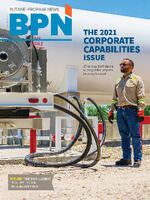
On July 28, a United States magistrate judge in Billings, Montana, ruled on multiple summary judgment motions and sent to trial a personal injury lawsuit that arose from a propane flash fire involving a barbeque grill. The case — which is still ongoing — is Copenhaver v. Cavagna Group, S.p.A.
Barbecue Party
On Sept. 3, 2017, Richard Burris held a barbecue for family and friends at his home in Glendive, Montana. Todd and Amber Copenhaver attended the event. Burris was using a gas grill fueled by a 20-pound propane cylinder. When he discovered that the propane cylinder was empty, he checked the regulator and hose assembly and turned off the grill. Todd Copenhaver had recently purchased a full, 20-pound propane cylinder from the local Albertsons grocery store. He offered to retrieve this cylinder from his home to save Burris a trip to the store.
Ball of Fire
Burris placed Todd’s cylinder in the grill cabinet and connected the grill’s hose and regulator to the cylinder valve. The connection was made by a 791 nut, which connected the valve on the cylinder to the regulator for the barbecue grill. He believed he had fully tightened the 791 nut when he made the connection.
Burris then opened the cylinder valve. He turned on one of the grill burners and ignited it. He did not hear or smell any leaking gas and proceeded to turn on and light the remaining burners. He closed the grill lid and went inside the house. He remained inside for a few minutes, then returned to find a one-foot-high ball of fire burning from the top of the cylinder. Flame also rolled out of the grill’s lower cabinet and up the front of the grill.
Burris ran into the house, calling for Todd’s help. He grabbed an oven mitt to turn the valve off. Todd also grabbed oven mitts and followed. Todd does not recall smelling gas but heard “hissing” that he assumed came from the cylinder.
‘Quiet Hiss’
Burris reached the grill and shut the cylinder valve off. He turned the valve handle until he hit the end point. The fire diminished to a small flame about the size of a pocket lighter, although later there was dispute about how quickly that happened. Todd blew the remaining flame out, then made sure the cylinder valve was fully turned off. He could not determine the origin of the flames beyond the general area of the valve.
The regulator hose had fallen away from the cylinder valve, and the valve outlet was clear. There was a continuing leaking noise, later described by Todd as a “real low, quiet hiss.” (He assumed it came from the cylinder.) Todd could also smell a little bit of propane.
‘Click, Pop’
Todd told Burris they needed to move the cylinder into the yard. He reached into the cabinet with his left hand and grabbed the cylinder. He saw no flame. But as he moved the cylinder, he heard a “mechanical sound,” like a “mechanical click, pop.” The sound startled him, and he dropped the cylinder. He stated he saw a flame either before or after dropping the cylinder.
Todd reacted by leaping through the flame toward his wife Amber, who was across the deck, to remove her from harm’s way. Todd later testified that he thought the flame shot out 10 feet parallel to the house. The flame severely burned his leg, left arm and hand, and Amber injured her hip as she and Todd fell off the deck. Both were hospitalized.
Defective Valve?
The Copenhavers filed suit against Cavagna Group, S.p.A., the manufacturer of the cylinder valve, and against AmeriGas Propane and Albertsons as the resellers and distributors of the cylinder. They claimed there was a leak in the rubber sealing gasket inside the cylinder valve. They claimed it was defectively designed and the materials in the sealing gasket were defective, compromising the seal and allowing the leak. They sought actual damages for their injuries, as well as punitive damages.
The defendants responded that the valve was not defective and that Burris and Todd had assumed the risk of injury and had not followed the cylinder’s safety instructions by failing to leak test the fittings with soapy water prior to use.
All parties filed motions for summary judgment, and these motions were referred to a magistrate judge for his findings and recommendations to the District Court. This referral procedure is often followed in federal court cases, and the District Court judge is free to accept or reject the recommendations.
Leak Source
The magistrate judge first considered Cavagna’s summary judgment motion. Cavagna argued that the source of the leak could not have been the cylinder valve and that in any event, the incident would not have happened if a leak check of the valve and fittings had been done with soapy water, as directed by the grill’s owner’s manual. The magistrate rejected both arguments, finding that there were disputed fact issues on both questions, and it was up to the jury to resolve them.
AmeriGas and Albertsons moved for partial summary judgment on the punitive damages claims against them. They argued that as resellers of the allegedly defective cylinder, they did not know of the allegedly defective valve seal. The magistrate granted Albertsons’ motion, relying on evidence from its safety director that it had no such knowledge.
Prior Knowledge
The magistrate held that the jury should decide whether punitive damages against AmeriGas are appropriate. First, he pointed to evidence that AmeriGas was a party to three prior lawsuits involving Cavagna valves, and that in one case the AmeriGas “expert testified that the Cavagna valve in that case had the same defect Copenhavers allege here.” In addition, valve leak issues were discussed in meetings of the National Fire Protection Association and National Propane Gas Association, to which AmeriGas was a party.
Finally, the magistrate noted evidence of “email discussions” among AmeriGas representatives on the failure of cylinder valves. In these discussions, the risks of valve failures were acknowledged and could be the result of defective materials.
These risks, according to the internal AmeriGas discussions, “were at least prevalent enough to consider a recall of the valves or cylinders as an option.” The magistrate concluded that “these facts are sufficient to raise an issue of material fact with respect to Copenhavers’ punitive damages claim against AmeriGas, and summary judgment would not be appropriate.”
Assumption of Risk
The magistrate then held that Cavagna did not have sufficient evidence to assert the defenses of product misuse and assumption of risk. He recommended that the Copenhavers’ motion on these defenses be granted and that Cavagna not be allowed to assert them. The Copenhavers also sought partial summary judgment on the issue of liability, but the magistrate concluded this was a disputed issue for the jury to resolve and recommended denial of this motion. On August 13, the U.S. district judge adopted the magistrate’s findings and recommendations. As stated above, the case is ongoing and no trial date is currently set.


